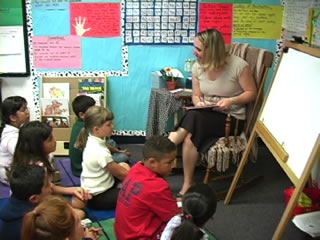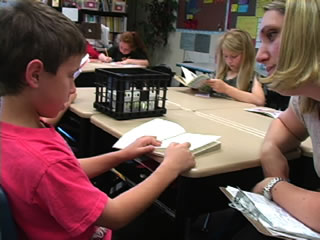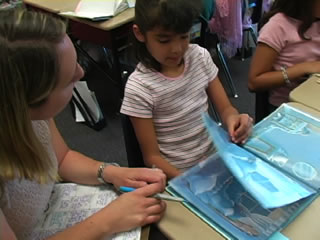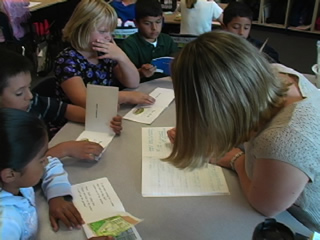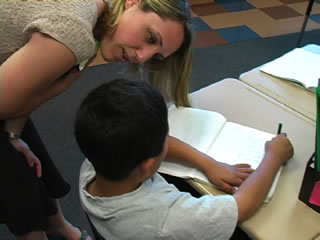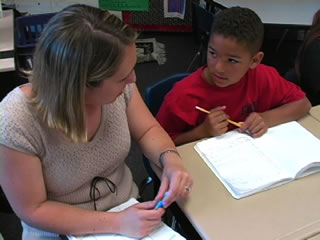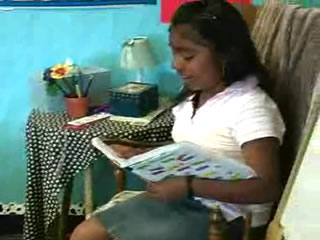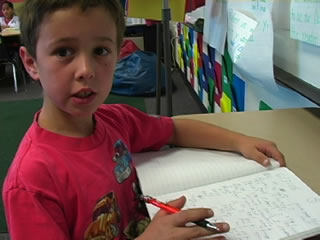Documentation
of Teaching/ Classroom Videos |
| Document |
Commentary |
| |
Each morning my class and I begin with the same opening routine. We begin by taking attendance, the lunch count, and any other announcements that are important. I always begin my attendance by greeting each student with “Good morning, and their name.” I think it is important to keep the same structure each day in the classroom. Students seem to succeed more when this is in place. |
Readaloud |
|
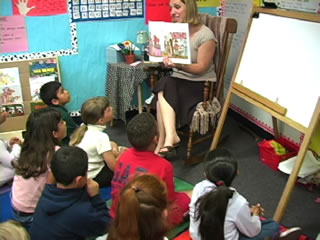 |
| Myers reads "Strega
Nona" (Tomie de Paola) and alerts students to be looking
for text-to-text connections. |
play
|
Quicktime
Player
high • low
get
plugin |
Windows
Media
high • low
get
plugin |
|
Following attendance, my students and I begin our Readers Workshop. In this clip, I have selected a read aloud that I think will best match my teaching point. Today, I am reviewing with my students how to make text to text connections. I will model how to make a text to text connection as I read aloud the book to my students using the think aloud approach. In addition, I will ask my students to turn and talk during the read aloud to share their thoughts with their peers.
|
Text-to-Text
Connections |
|
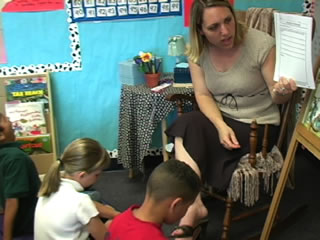 |
| Myers introduces
the worksheet students will use to note the text-to-text
connections they find during independent reading time. |
play
|
Quicktime
Player
high • low
get
plugin |
Windows
Media
high • low
get
plugin |
|
This worksheet will be given to the students for their independent work time. The students will need to look for their own text to text connections as they do their independent reading. It is very important that tasks that I ask the children to do are modeled thoroughly before by the teacher. In addition, these tasks make the students accountable for their work. I ensure that they are collected daily at the end of the workshop so I can look them over and assess my students. |
| |
Readers conferences are important during independent reading time for many reasons. For one, it allows me to differentiate instruction for all of my learners. I can find a teaching point for each student, and teach to it. In addition, it allows me to check to see if the independent reading book the student has selected is a just right book for them.
When I conduct a readers conference, I always begin by pointing out one thing I noticed the reader is doing that is positive. Then, as I listen to them read, I find the teaching point that I would like to leave the student with. During this time, it is also important to take an informal running record. This can be used for assessment purposes later on. |
|
Students in readers workshop read all different leveled books, however the same strategies are taught to each reader in the classroom. Most of the time, I will ask students to use one of their strategies to help them when they are stuck on a word or phrase. These strategies should be modeled thoroughly by the teacher before expecting the students to reference them on their own. An example that I teach my students is to “sound out the word” if they are stuck on the word. I always make the student repeat back to me what they will plan on working on. Then, I use that time to write down the teaching point in my conference notes. |
| |
During this readers conference, you can really see the structure that I follow with my students. I always begin by asking them, “Tell me what you are reading today. “ Then, I listen carefully as the student reads. In this situation, I noticed that the student became stuck on a word. I think it is important to always ask the student at that point, “What can you do as a reader to help yourself?” By doing this, the student is taking the initiative, rather than letting the teacher decide for them what strategy they should use when trying to decode the word. After the student has selected the strategy they would like to focus on, I have them try it out. Sometimes I help the students try it out, so we are working on the word together. Following this, I have found my teaching point that I would like the student to focus on for the remainder of the time. I always begin with one thing I am noticing the student is doing well. Then, I leave them with the teaching point, have them repeat it back to me, and I record it in my conference notes. |
| |
During this conference I have focused on a craft element that the student and I have noticed the author uses. The craft element was a repeating line throughout the story. Some conferences are shorter than others, like in this case. After hearing the student read for awhile, I leave her with my teaching point. In addition, I remind her what the assignment was for the independent work time. I do this by asking her, “Tell me what your job is today during readers workshop? “. After she confirms what it is, I move on to the next student to begin to confer with them. |
Getting
Started on Text-to-Text Connections |
|
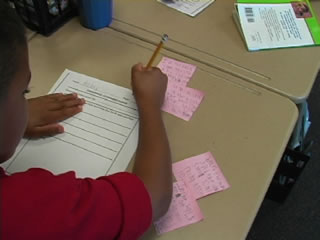 |
| Distributing the
worksheet for students to note text-to-text connections. |
play
|
Quicktime
Player
high • low
get
plugin |
Windows
Media
high • low
get
plugin |
|
The students have used sticky notes to mark the page where they have made a text to text connection as they were reading. This is to remind them where they made the connection as they read. (The sticky notes I place in the black bin located at each table). Then, I hand out the worksheet to them following their independent reading. This is usually thirty minutes after I have finished the mini -lesson. While the students work on their worksheet or activity, I use that time to call back another guided reading group that I need to meet with. |
|
|
My guided reading groups always follow the same structure and time frame (they typically last fifteen minutes each). The structure is as follows: Students reread a familiar book while I take a running record for assessment, a new book is introduced by me with vocabulary development, students practice reading it on their own, (while I listen to them read I leave each student with a teaching point) and then the whole group comes back together to discuss a strategy or skill I think they would all benefit on working on. Guided reading is important because it allows for differentiation in the classroom. Through guided reading, I am able to meet the levels of all of my readers. |
Sharing
Text-to-Text Connections |
|
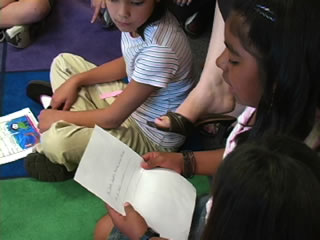 |
| Students share back
the text-to-text connections they found during independent
reading time. |
play
|
Quicktime
Player
high • low
get
plugin |
Windows
Media
high • low
get
plugin |
|
Another routine that is firmly in place in my classroom is the share out at the end of each workshop. This piece of the workshop is important because it allows students to reflect with each other, as well as hold them accountable for their work. It is also a nice and easy way for the teacher to assess the students. I can quickly tell students who are successful or may still be struggling following the share out. |
Writers'
Workshop Mini-Lesson |
|
 |
| Myers describes
turning previously noted items into a "notebook entry" |
play
|
Quicktime
Player
high • low
get
plugin |
Windows
Media
high • low
get
plugin |
|
During the writers workshop mini lesson, I am modeling what I would like the students to try by using my own personal notebook. I think it is important for the students to see that I am a writer as well in the classroom. Since this was at the end of the school year, I am having my students revisit their previous notebook entries in the hopes that maybe they will want to turn an old entry into a new one. The notebooks in my classroom are not a journal, but rather a place for students to collect their ideas for future stories. |
| |
This is a good example of how a teacher needs to “catch up” a student when they are absent from school. Many of the lessons in writers workshop build on each other, so it is often necessary to conference with those students first to get them back on track. |
|
|
This conference is especially important because the student I was conferring with needed to reminded of what a narrative story should have. During the conference, I decided to take sticky notes and write down the attributes of what a narrative story should have. Sticky notes are helpful in situations like these, because you can leave it with the student as a good reminder for them. Another thing you may have heard in this video clip is the music playing in the background. While my students write, I always have classical music playing lightly in the background. I find that this helps them focus better during writing time. |
| |
Just like the other conferences I began this one with the question, “Tell me what you are working on today as a writer?” It became clear to me that the student in this clip was debating between two different topics to write more about. At that point, I decided to explain what my purpose was for being there during the conference stating to the student, “ I’m here today to help you decide what your topic will be so you can write more about it. “This really helped the student and I focus during the conference. By the end of the conference, he had his topic that he was going to write more on. I made sure this was a topic he was comfortable writing more about. I think that it is important students make those decisions, so they have “buy in” with the workshop format. |
Writer's
Conference |
|
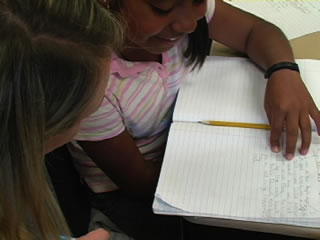 |
| Myers has a writer's
conference during writer's workshop, and asks this
student to share her story in author's chair. |
play
|
Quicktime
Player
high • low
get
plugin |
Windows
Media
high • low
get
plugin |
|
During this conference, I begin by complimenting the student on something positive that I notice she is doing. Following this, I ask her what her next steps are. Then, I decide to give her a suggestion. It is not necessary that the student takes the suggestion from me. Sometimes I will give a suggestion instead of a teaching point if I notice that the student is doing fine on their own. The one thing I always make sure I do is check with each student before I have them share in the author’s chair. Since writing is very personal, I make sure that the student is comfortable first sharing it, before they agree to share it with an audience. If they agree to share, then I make sure that the student and I are on the same page with what it is that I want them to share, because I try to link it back to what was taught during the mini lesson. |
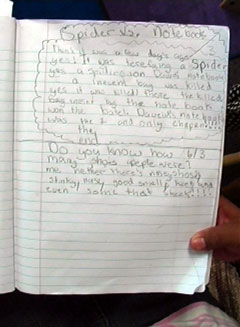
this student's story. |
This is an example of a notebook entry that a student wrote. They took an idea of something that actually happened in class (a spider was on a students notebook) and turned that memory of the event into a notebook entry. This notebook entry may be used later on by the student for an idea to write a story about. |

Another student's story. |
This is another example of a type of a notebook entry that this student wrote about. It is of a memory from a previous event that happened to them. As you can see, the notebook entries are not from a prompt given by the teacher. Students are able to write their own ideas and entries in their personal notebook. Perhaps this student will reference this entry later on for a future story idea that will be taken through the writing process. |
| |
The author’s chair is just one way of sharing students work after writers workshop. I always try to make my share outs meaningful. I try to select a student that is modeling my teaching point from the mini lesson within their own writing. Following the author’s chair, the student author calls on one person in the class who has a positive comment for their writing, and then calls on another student who has an appropriate suggestion, or something they would like that student to try out in their writing on a different day. A positive comment might sound like this: “I really like how you described your main character in great detail. I really had a picture painted in my head about what they are like. “An appropriate suggestion might sound like this: “I really like your character development, however I am still not sure where your setting is of your story. Do you think you can try to add more details about your setting so I can clearly understand where your story is taking place? “ |
| |
Word study is taught separately from writers workshop. I spent twenty minutes daily on teaching word study. The dry erase whiteboards have been a useful tool that I use to help teach various skills. They are easy to clean, with zero prep work involved. I always make sure that I teach my students how to correctly use the whiteboards, dry erase pens, and erasers. Word study encompasses many different things. Some things that are taught during word study time include: high frequency words, grammar, and punctuation. |
Reflections
on Teaching |
| Document |
Commentary |
Teacher
Reflection |
|
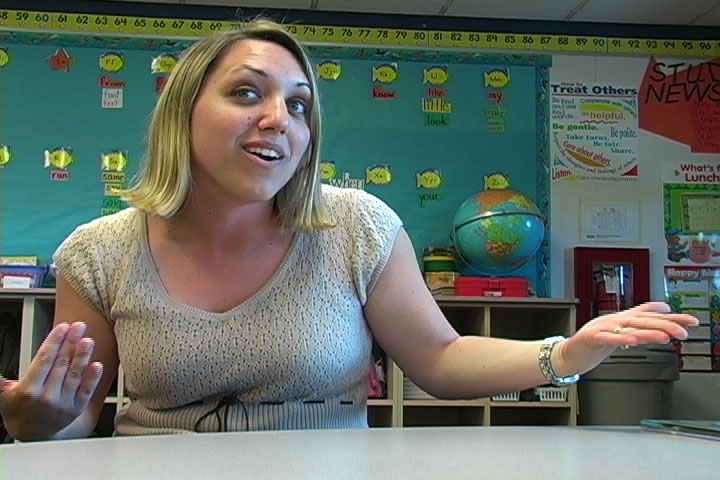 |
| Myers reflects on
readers' and writers' workshop, differentiated instruction,
and standards. |
play
|
Quicktime
Player
high • low
get
plugin |
Windows
Media
high • low
get
plugin |
|
As I watch the video of me being interviewed, it became clear to me how much I believe in the workshop format for teaching. I think that my philosophy in being a life long learner will transfer to my students too. My hope is that my students will see my motivation to continue to learn, and follow that lead as well! |
| |
Teacher Reflection on Student Interviews:
Perhaps one of the reasons why I believe in writers workshop so much is simply because my students are able to have conversations with each other all about writing. These discussions have them reflecting on their own writing. My students are able to write for an audience and make references to the different genres, as well as describe what they are in great detail. During this clip, you will also see my students making references to the posters that are in the classroom. Students are able to identify and describe key terms in writers workshop, without the assistance from me. From these interviews, I think it can be clearly seen how writers workshop empowers students in their own writing and thinking. |
Pedagogical
Context and Materials |
| Document |
Commentary |
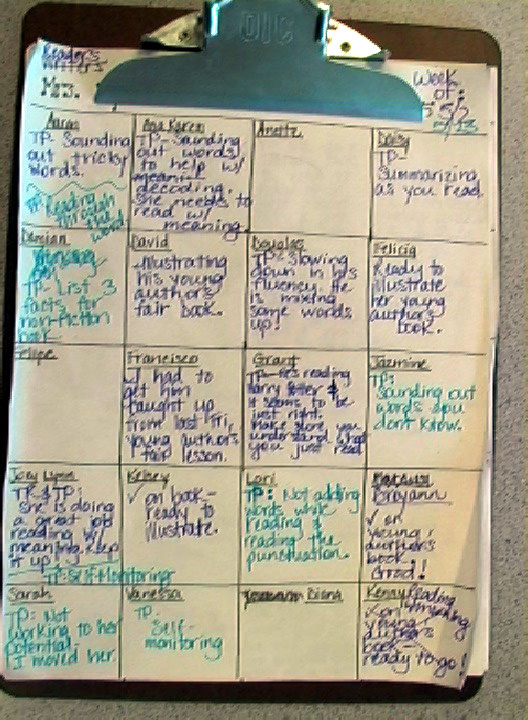
Readers' workshop conference chart |
I used this template for taking notes during the ’04-’05 year. I like this template because you can easily see who you have met with throughout the week. This year however (’05-’06), I switched to a notebook with tabs on the side representing each student (using their initials for confidentiality). I like this method a little more, simply because I have more room where I can record my notes. As you can see from the template in the picture, there isn’t very much room to take detailed notes during a conference. |

All text-to-text connection worksheets
(Adapted for the primary grades from Guided
Comprehension: a Teaching Model for Grades 3-8 by
Maureen McLoughlin and Mary Beth Allen © 2002, Newark
DE: International Reading Association)
|
This worksheet I photo copied from a book, however many of my worksheets I also create on my own. Students do not always get a worksheet each day. Sometimes they respond in a readers journal, or simply on a sticky note. If a student finishes their task early before we come together to share, I always have them go back and practice their independent reading some more. |

Interactive Classroom
Wall |
Readers' workshop charts and posters
Many of the charts that I have for readers workshop I created on my own. I do save them in my files for the following year if it is applicable. Most of the posters for readers workshop stay up throughout the year after the lesson has been taught. This is simply because many of them have strategies that the students will use for reading throughout the year, so I want them to have access to it. The posters are never hung up before a lesson has been modeled and taught thoroughly. |

Interactive Classroom
Wall |
Writers' Workshop and Word Study Charts and Posters
In writers workshop the posters come down after each genre study is finished. This is because the students will need to have access to the new ideas in the next genre study. It is also to lessen the confusion between the genres as well as to make room for the next study. As with readers workshop, I create most of the posters myself and I save them for the following year if applicable. |

Gallery of Images
|
Language mechanics charts and posters
Posters are also created for word study lessons. These posters I do leave up throughout the year, because I want my students to have access to them to help them with various skills while writing. As with readers and writers workshop posters, I only post them in the class after the lesson has been modeled and thoroughly taught. In addition, I save these posters in my files if applicable for the following year. It has saved me time from reproducing each poster every year! |
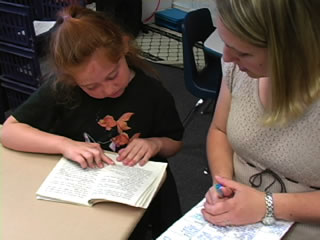 Living
the Life of a Reader and Writer
Living
the Life of a Reader and Writer 